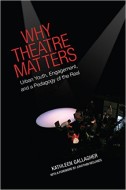Book Review: Why Theatre Matters: Urban Youth, Engagement, and a Pedagogy of the Real
Why Theatre Matters: Urban Youth, Engagement, and a Pedagogy of the Real
Kathleen Gallagher
Toronto, Canada: University of Toronto Press, 2014
ISBN 978-1-442-62694-2
320 pp.
The mere title of Kathleen Gallagher’s new book, Why Theatre Matters, impelled me to read it immediately. Gallagher, who is not a theatre practitioner herself, but a pedagogic and ethnographic researcher, makes a compelling case for how drama classes make a difference in urban schools throughout the world. She substantiates her claims by drawing upon an impressive array of materials, anchored in her own quantitative and qualitative analyses of classroom engagements in Toronto, Boston, Lucknow, and Taipei, which she compares and contrasts with hundreds of similar studies and books devoted to theatre and urban pedagogy. This book is a must for every institution with a School of Education and especially Theatre Education programs; it would be difficult to find another volume that builds such a comprehensive and persuasive argument for the primacy of theatre in urban education as this one.
Gallagher’s subtitle–Urban Youth, Engagement, and a Pedagogy of the Real—rather than theatre, is the actual subject of the book, which explores how drama classrooms become the site for open and frank discussions of class, privilege, and empowerment and a means for students to grapple with the social, political, and economic realities of their lives. The secondary school teachers profiled here work in poor neighborhoods without a lot of resources or support for their creative pedagogies. Their students are complicated people who come from fraught home environments where they are often responsible for earning a living and caring for others. Simply getting to class is a challenge; one girl describes the lack of bus fare to get to school while others spend so many hours working in paying jobs that they don’t have time to do homework and often are too tired to go to school. It is difficult for teachers to sustain a planned curriculum, since they can’t count on students being able to build knowledge and skills over time. Hence, when successful outcomes occur—and Gallagher gives many examples of these—it’s a cause for cautious optimism, at best. A great strength of the book is its focus on student perspectives; pages are devoted to verbatim transcriptions of student-teacher-researcher focus group sessions where the complexities of people’s lives and their interrelationships, in and outside the classroom, are fully exposed.
One of the most profound lessons I took away from this book is to beware feel-good narratives that celebrate the transformative power of art. Although some of these success stories are real, they are always far more complicated than the tales Hollywood would tell. In them, the urban teacher—usually white—is the “noble savior” of the underprivileged—usually black—students. Gallagher cautions that we don’t fall prey to our liberal humanist imaginings and neglect to see how much Whiteness, privilege, and unequal power underlie these heroic tales. As an assiduous chronicler of the urban youth she is dedicated to understanding, she always gives students the last word, which, more often than not, tells it like it is.
Marti LoMonaco
Fairfield University

